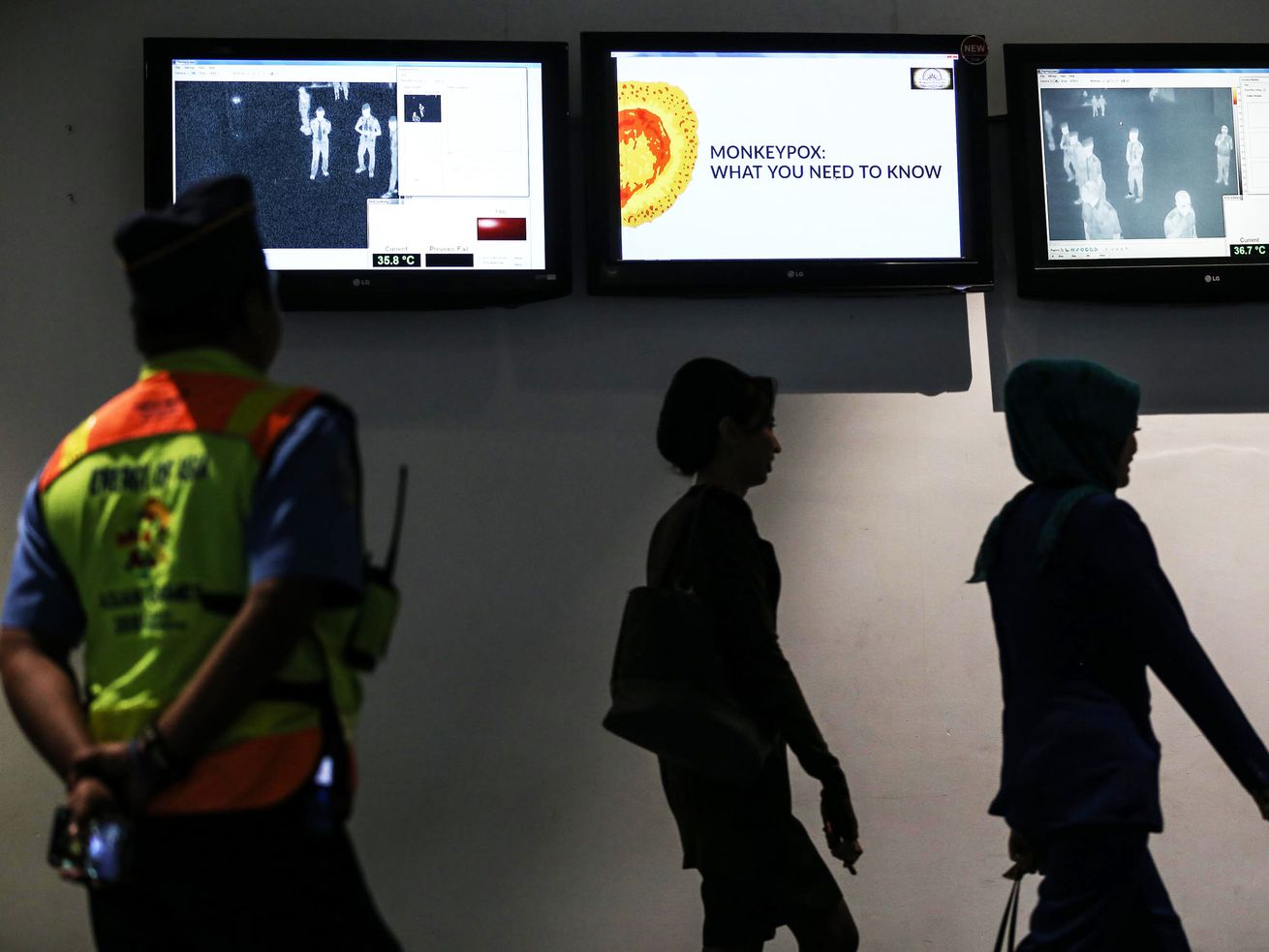Health experts are optimistic monkeypox can be contained. Here’s why, and where it could go wrong.
As of May 26, the global monkeypox case count tops 350, with cases spread across 23 countries. It’s easy to get a little shpilkes while wondering, what exactly are we in for? How big will this outbreak get, and how long will it be around?
In the early days of any outbreak, epidemiologists try to answer these questions by first asking a different one: Is this virus containable? That is, can its spread be stopped before it gets out of control?
If it is, that means the outbreak could be in our rearview mirror before the autumn. But if not, the public — and public health — could be in for a long slog.
When it comes to monkeypox, many experts — including several I spoke with for this story — have emphatically said yes, this outbreak is containable. “There’s a solution just over the horizon,” said William Schaffner, an infectious disease and public health expert at Vanderbilt University Medical Center. “This is one that I think we can nip in, if not in the bud, certainly in the flower.”
Epidemiologists assess containment potential on the basis of a few different categories: the biology of the germ itself, the immunity and compliance in communities in which it’s spreading, and the public health capacity to respond. When it comes to monkeypox, experts assessing these factors feel reasonably confident this outbreak won’t swell to pandemic proportions. However, there are some vulnerabilities monkeypox can exploit to stick around longer.
How exactly could the monkeypox outbreak play out? It comes down to these key factors.
The biology of the monkeypox virus makes containment likely
When epidemiologists are wondering if an outbreak can be contained, they start by considering the pathogen itself. Its innate characteristics determine how far of a reach the virus could have, and help experts figure out how to intervene in its spread.
The first thing to consider is the route of transmission, said Eric Toner, a senior scholar at Johns Hopkins Center for Health Security. Most monkeypox transmission happens by skin-to-skin contact (although it also can be transmitted between people through respiratory secretions, via skin lesions, or exposure to recently contaminated objects). That makes it harder for one person to infect multiple people than it would be if the virus were primarily spread through the air.
Whereas a more primarily airborne virus like SARS-CoV-2 can turn a choir practice into a superspreader event, monkeypox is unlikely to spread as explosively because infection requires direct contact.
A second important variable is the incubation period, the time period between the moment of infection and the moment symptoms start. The longer a germ’s incubation period, the more time there is to intervene with measures that prevent spread, like quarantine or vaccination.
Monkeypox’s incubation period is typically between 7 and 14 days (although it can range from 5 to 21 days). That’s a relatively long time, and it gives public health authorities a fighting chance at reaching infected people via contact tracing, in time to prevent them from becoming a source of transmission, either through quarantine or vaccination, Toner explained.
A third key attribute, Toner said, is a pathogen’s ability to spread before it makes people sick (i.e., if it can be asymptomatically transmitted).
Monkeypox is not thought to spread before people develop symptoms, which include fever, body aches, lymph node swelling, and a rash. That means it’s much easier for a person to notice when they might be contagious — and to take action by getting medical attention and isolating at home. (In contrast, Covid-19 can spread before a person starts to feel ill, which has made it very hard to contain.)
/cdn.vox-cdn.com/uploads/chorus_asset/file/23591038/GettyImages_2067974.jpg)
CDC via Getty Images
The features of the symptoms themselves can also make it easier to control an outbreak.
“You can look at somebody across the room and know that they have smallpox, for example, because they have a rash that no one would miss,” Toner said. Monkeypox’s rash is slightly less striking, he said: At different stages, it can mimic chickenpox, herpes, and syphilis.
However, it is still distinctive enough that most clinicians will make the diagnosis without having to wait for a test result to come back — especially after the raft of information they’ve been receiving lately about monkeypox.
In contrast, the symptoms of Covid-19 frustratingly resemble other common illnesses like colds and flus, making it harder to identify without testing.
But the virus can exploit some vulnerabilities
All that said, there are a few aspects of monkeypox that could vex containment efforts.
While most lesions are painful, it might not be obvious to every infected person that they have monkeypox, especially early in the course of infection.
That is particularly salient in this outbreak, where many infected people have been reporting a rash localized to the genital area, often after close social or sexual contact. “Sometimes it’s dark, and you don’t inspect that very carefully,” Schaffner said, “so there are environments where transmission can occur, particularly if the contact is kind of semi-anonymous or fleeting.” In those scenarios, it might not be obvious to an infected person that they have symptoms and could be contagious. This concern could be mitigated with good public outreach (more on that below).
Overall, the virus’s biology and how it causes disease in humans suggest it should be containable. But there’s also the reality that many populations are less immune to monkeypox than they have been in the past.
There was a time when everyone at risk for smallpox infection had been vaccinated against it. But since smallpox was eradicated in 1980, global smallpox vaccination campaigns have ceased — and the public’s protection against related viruses, including monkeypox, has waned. In 2020, the Pasteur Institute suggested that as smallpox vaccine protection dwindles, monkeypox is gaining epidemic potential.
Although people who are old enough to have been vaccinated against smallpox still have some protection, they’re not the ones who are at greatest risk during the current outbreak, which is largely affecting younger people, said Agoritsa Baka, a public health preparedness expert at the European Centre for Disease Prevention and Control. “Right now, most of the public, and particularly the groups that we’re interested in, are largely unvaccinated, so they are vulnerable to the virus,” she said. That makes this outbreak harder to contain than it would be if more people were immune.
A final caveat is that experts’ understanding of monkeypox’s inherent containability hinges on the fact that the virus isn’t changing quickly (i.e., mutating) to evade control.
Sequencing data obtained to date do not suggest the virus is evolving rapidly — and researchers don’t expect it to, tweeted Trevor Bedford, an epidemiologist and viral disease modeler at the Fred Hutchinson Cancer Center in Seattle. Still, the world will be watching closely to determine whether genetic variability of the monkeypox virus is playing a role in its current spread, and its potential to be kept in check.
/cdn.vox-cdn.com/uploads/chorus_asset/file/23590956/AP22140456460244.jpg)
Andrew Medichini/AP
“Will it be contained” depends a lot on the communities the virus is spreading in
Even when a germ’s intrinsic qualities favor its containment, it can cause big problems if there’s stigma associated with the activities that spread it.
With monkeypox, homophobia could jeopardize disease control, because links have emerged between cases and attendance at venues catering to men who have sex with men. If infection risk gets too closely associated with behaviors that some people stigmatize, it might prevent them from cooperating with contact tracing or vaccination for fear of being associated with those behaviors.
Health organizations run by and for gay men are an enormous asset to public health right now, and many of those organizations have longstanding relationships with public health, several experts told me. “Gay and bisexual men have been faced with HIV as a threat for three or four decades now, and we have a very activated community of people who are engaged in getting diagnosed and getting treated,” said John Brooks, chief medical officer at the CDC’s division of HIV prevention.
And it’s not just men’s health groups who’ve helped educate and inform people in the LGBTQ community about monkeypox, Baka said. At least one festival linked to cases has posted a notice of infection risk on its website, and last weekend, two dating apps commonly used in Europe by gay and bisexual men began displaying public health messages about monkeypox in several languages.
That kind of community buy-in helps key information reach people who might otherwise be skeptical of engaging with government public health agencies. “The challenge definitely is to engage with the community so that people can go get tested without prejudice,” said Baka.
When a disease’s modes of transmission are highly stigmatized, messaging related to the disease has to walk a careful line.
On one hand, frank communication in language that out gay and bisexual men commonly use is best for efficiently providing these communities with non-judgmental information. “If you treat people with respect and meet them where they are, it can go a very long way,” said Brooks.
On the flip side, trumpeting the link between infection risk and getting close and sweaty at events for LGBTQ people can instigate stigma, Schaffner said. An ideal communications strategy likely uses different language and emphasizes different elements of risk with different populations.
So far, Schaffner has been glad to see these associations often mentioned without sensationalism, even in news reports. “It’s not the lede,” he said, but “the third paragraph of the story.”
Containing monkeypox will take effort in a strained-but-prepared public health system
As the Covid-19 pandemic demonstrated, a robust public health system is a necessary ingredient of outbreak containment.
Baka said that in this case, pandemic fatigue is to some degree a threat to containment. “People are tired. All the health care workers are tired, including the public health workforce,” she said.
/cdn.vox-cdn.com/uploads/chorus_asset/file/23590566/GettyImages_1053131658.jpg)
Charles Bouessel/AFP via Getty Images
But there’s still a lot of optimism they can control the monkeypox outbreak, she said, in part because that workforce is so experienced at curtailing infection transmission, whether the infections are sexually transmitted or not. Additionally, as a result of Covid-19, new technologies exist to make contact tracing easier than it used to be.
“This does require a lot of shoe-leather epidemiology,” Schaffner said, referring to the contact tracing epidemiologists do to identify cases and contacts during an outbreak, sometimes by pounding the pavement in person.
It’s also immensely helpful to have vaccines and medications that we know can prevent and treat monkeypox at the outset of this outbreak. The US Food and Drug Administration has approved several medications to treat smallpox, which CDC representatives said Monday could also be used to treat monkeypox. The Strategic National Stockpile contains three types of smallpox vaccines, which would also prevent monkeypox.
What’s unique and particularly helpful about the existing vaccines is that they work to protect people who receive them even if they’re vaccinated after they’re exposed, said Toner. Vaccination within four days of exposure can block infection altogether, he said, and vaccines still lessen the disease’s severity even if given later in the course of infection.
That makes vaccinating cases and ring vaccination — vaccinating all the contacts of a case — a viable strategy for preventing the spread of infection, adding another point in favor of monkeypox being containable. Already, public health authorities in several European countries and the US are deploying these strategies, offering monkeypox vaccines to close social and health care contacts of cases.
Containment is possible. But the window could soon start closing.
Several experts were up front about why taking aggressive measures to contain monkeypox now are particularly urgent: Pride celebrations are coming up, and two-plus years into the Covid-19 pandemic, people are eager to party, said Brooks. “If there were to be non-compliance with containment measures, and it started transmitting more among the broader population, then it would be harder to contain,” Toner said.
There are backup plans: If the current containment strategies of contact tracing and ring vaccination don’t work, escalated vaccination strategies could involve vaccinating people in groups at high risk for infection or severe disease, regardless of whether they are cases or contacts. That would mean offering vaccines to people attending large gatherings where they’re likely to engage in the kind of contact that spreads monkeypox, such as certain Pride festivities. Meanwhile, groups offered the vaccine due to higher risk for severe disease would likely include immunocompromised people, including people with HIV, as well as pregnant people and children — but we’re not there yet.
For now, vaccine availability is not a problem, as many countries have stockpiles of smallpox vaccine as part of their bioterrorism preparedness strategies. However, companies that make these vaccines are ramping up production in case a larger supply is needed.
Fundamentally, an outbreak is likelier to be stopped in its tracks if it’s caused by a pathogen public health has successfully fought before, either with medicines or proven strategies like ring vaccination. And that’s also why experts are so optimistic. “That’s how smallpox was eradicated, and I believe that’s how monkeypox will be contained,” Toner said.
The smaller an outbreak is, the easier it is to contain. A plateau of the monkeypox case count would be a promising sign that things are headed in a positive direction. Over the next few weeks, epidemiologists — and the world — will be watching to see if their hopes of curbing this virus’ spread are fulfilled.
Author: Keren Landman
Read More



